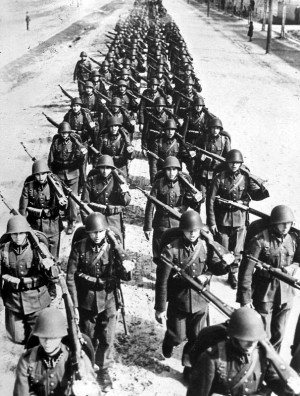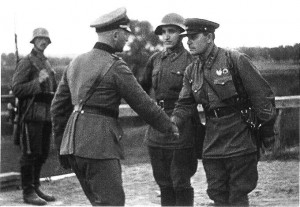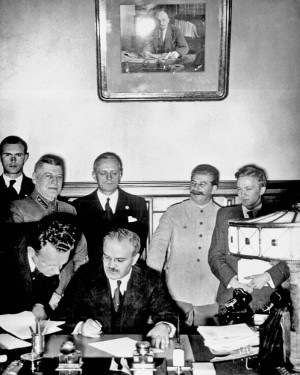 The Invasion of Poland in 1939 marked the start of World War II. It was led by the Nazis, a small contingent of Slovaks, and the Soviet Union. The invasion from Germany started on September 1, 1939 following the signing of the Molotov-Ribbentrop pact, while the invasion from the Soviet Union started slightly later on September 17th. The campaign was short lived and ended on October 6, 1939 with the division of Poland by Germany and the Soviet Union.
The Invasion of Poland in 1939 marked the start of World War II. It was led by the Nazis, a small contingent of Slovaks, and the Soviet Union. The invasion from Germany started on September 1, 1939 following the signing of the Molotov-Ribbentrop pact, while the invasion from the Soviet Union started slightly later on September 17th. The campaign was short lived and ended on October 6, 1939 with the division of Poland by Germany and the Soviet Union.
The invasion was launched from two sides, with the Polish quickly showing their weakness in their defeat at the Battle of the Bzura. Poland was reliant on help from France and the United Kingdom with whom they had signed pacts, but help in the campaign from the two countries was very limited. The Polish were defeated once again in the Battle of Kock on October 6th, giving Germany and the Soviet Union total control over Poland.
The Invasion of Poland
The invasion of Poland by Germany began at 4:45 am on the 1st of September, when the Germans opened fire on the Polish garrison at Danzig. The invasion of Poland by the Germans was carried out by 62 divisions and 1,300 aircraft.
 The decision to invade Poland by Adolf Hitler was seen as a gamble. With the German army still not at full strength and the economy still in peace time production, the planned invasion was seen as risky by Hitler’s generals, and as a result, some of the plans were leaked to France and the United Kingdom.
The decision to invade Poland by Adolf Hitler was seen as a gamble. With the German army still not at full strength and the economy still in peace time production, the planned invasion was seen as risky by Hitler’s generals, and as a result, some of the plans were leaked to France and the United Kingdom.
Hitler’s generals asked for more time to complete their defenses before the attack, but Hitler ignored their demands and continued with his plan. He believed that the invasion of Poland would result in a quick and easy defeat, and that the prime ministers of France and Britain would ask for a peace settlement rather than a war.
Revision of the Treaty of Versailles
Hitler’s annexation of Austria resulted in a revision of the Treaty of Versailles that had originally been drawn up in 1919. It was from this success that he deduced he would be able to invade Poland successfully, as he saw weakness in the Western Powers of France and Britain. Both countries had already accepted rearmament from Germany in 1935 and, in 1938, had reluctantly agreed to the transfer of Sudetenland from Czechoslovakia to Germany. Germany had quickly become an intimidating force and this was reinforced by the inaction of the Allied powers.
Devastation by the Luftwaffe
The Luftwaffe was instrumental in the occupation of Poland, as it caused mass devastation in the cities. Hitler also ordered the occupation of Czechoslovakia and regained Memel from Lithuania. He forced the construction of railways to link East Prussia to Germany by the Polish. East Prussia has been separated from Germany in 1919 and Poland had lost its independence as far back as 1795. The annexation of Czechoslovakia by Hitler had gone against a written guarantee that had been issued in Munich in 1938 and when Hitler ignored demands from Chamberlain, it lead to the invasion of Poland. Hitler started preparation for the invasion on April 3rd, convinced that Chamberlain would not send Britain to war in defense of Poland and convinced that France would not act alone.
Soviet-Nazi Pact
 The only real concern that Hitler had with his plans to invade Poland were that he might trigger alarm in the Soviet Union. Stalin had feared a German invasion for many years, but by July of 1939 the terms for an anti Nazi coalition with Britain and France had still not been agreed on.
The only real concern that Hitler had with his plans to invade Poland were that he might trigger alarm in the Soviet Union. Stalin had feared a German invasion for many years, but by July of 1939 the terms for an anti Nazi coalition with Britain and France had still not been agreed on.
The Soviet Union was not allied with Poland either, and Hitler saw this as an opportunity to go into negotiations with the Soviet Union. The negotiations resulted in the signing of a Soviet-Nazi pact on August 23, 1939 with both forces setting aside their antipathy in favor of national gain and the restoration of old borders.
Invasion
The date for the invasion was brought forward to August 26th, but this was later cancelled when Italian ally Mussolini declared that his country was not ready to go to war. Although Hitler felt that he did not need the military support of Italy and was not bothered by the Anglo-Polish treaty, he set the date of the invasion for the month of September.
On the 1st of September, Warsaw was bombed while Poland was invaded simultaneously from Prussia in the north and Slovakia in the South. Germany dominated the air battle from day one, as most of Poland’s air force was caught on the ground. The Luftwaffe bombed concentrations of Poles as well as roads, railways, and towns. All strong points in the German path were successfully destroyed and the Polish were never even given time to regroup.
At 8 a.m. on the 1st of September, Poland asked for military assistance from France and Britain, but Britain waited until the 3rd of September to declare war on Germany. France then declared war on Germany the same afternoon.
Response from the west
The Polish were subdued by Germany as they were totally unprepared for the Blitzkrieg invasion technique that was used. They expected a probe of artillery before a full blown invasion as was common in World War I. There was no offensive strategy in place, France expecting to fight a defensive war, another strategy left over from World War I.
By September 6th, Poland was completely cleaved apart with the Polish artillery an insufficient match for Hitler’s troops. By the 8th of September, the troops were approaching Warsaw, having covered 140 miles in just eight days. The only hope was an offensive from France and Britain, but these hopes were short lived. On the 17th of September, the Polish border was crossed by the Red Army, leaving Poland with no prospects but to surrender. Warsaw finally gave up any hope and surrendered on the 27th of September after 18 continuous days of bombing and destruction. However, Hitler’s gamble had not produced the results he had hoped for, as Britain and France refused to accept his peace offer and began launching offensives against the German military.